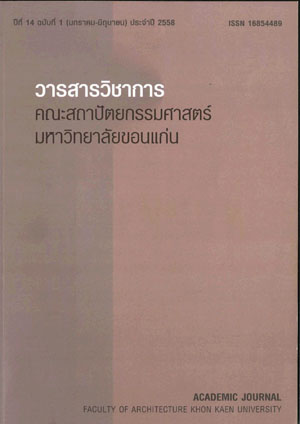เฮือนไตในลุ่มน้ำโขง : ไทย ลาว เมียนม่าร์
คำสำคัญ:
เรือนพื้นถิ่น, เฮือนไต, ลุ่มน้ำโขง, Vernacular house, Huean Tai, Mekong Regionบทคัดย่อ
บทความวิจัยนี้มุ่งศึกษาเปรียบเทียบเรือนพื้นถิ่นในชุมชนไตที่ตั้งถิ่นฐานในสามพื้นที่ของสามประเทศ ประกอบด้วย เมืองเชียงตุง ในเมียนม่าร์ เมืองเชียงฮ่อน แขวงไชยบุรี ในลาว และจังหวัดเชียงราย พะเยา และน่าน ในไทย โดยศึกษารูปแบบผังบริเวณ ผังพื้นเรือน รูปลักษณ์ รูปทรง การตกแต่ง ของเรือนพักอาศัยกลุ่มชาติพันธุ์ไตว่า มีความเหมือน ความแตกต่างหรือไม่ อย่างไร ผลการศึกษาพบว่า มีความสัมพันธ์เชื่อมโยงกันหลายด้านหลายมิติ แต่ไม่ได้เป็นรูปแบบเดียวกันทั้งหมดหรือทุกองค์ประกอบในทุกกลุ่ม เช่น รูปลักษณะโดยรวมเป็นเรือนยกใต้ถุนสูง เหมือนกันทุกกลุ่ม รูปทรงหลังคาเป็นจั่วผสมเป็นส่วนใหญ่ และมีตะแหลวป้องกันสิ่งอัปมงคลที่ทางเข้าเรือนยกเหมือนกัน ความที่เป็นกลุ่มชาติพันธุ์ที่มีรากวัฒนธรรมอันเดียวกันในพื้นที่ศึกษานี้ ทำให้มีความสอดคล้องกันหลายประการ แต่ก็มีหลายประการที่แตกต่างกัน อันเนื่องมาจากวิถีชีวิตที่ต่างกัน เพราะถิ่นฐานที่ตั้ง ความเจริญ ภูมิอากาศ ฯลฯ ที่ต่างกัน เฮือนไตแบบประเพณีดั้งเดิมในไทยหลงเหลืออยู่น้อย ส่วนหนึ่งที่เหลืออยู่เกิดจากแนวคิดหรือกระบวนการ อนุรักษ์ เช่นที่เรือนนางแสงดา เรือนจำลองหรือเรือนที่สร้างขึ้นใหม่ตามรูปแบบประเพณีที่บ้านธาตุสบแวน บ้านศรีดอนชัย แต่ในเชียงตุงและไชยบุรีนั้น ยังไม่มีแนวคิดด้านการอนุรักษ์ใดเข้าไปชัดเจนนัก การคงอยู่ของเฮือนไต แบบประเพณีจึงเป็นไปโดยธรรมชาติ เพราะปัจจัยด้านลบต่างๆ เช่น สภาพสังคม เศรษฐกิจ ความเจริญทางวัตถุ ยังเข้าไปไม่ถึงและส่งผลมากนัก จึงมีความหนาแน่นของเฮือนไตแบบประเพณีมากกว่า ในชุมชนมีบรรยากาศ แบบดั้งเดิม มีความเป็นสถาปัตยกรรมพื้นถิ่นมากกว่าในไทยมาก
Tai Houses in the Mekong Region: Thailand, Laos, Myanmar
Suebpong Chansuebsri
The study focused on comparing the vernacular houses in the Tai communities in Chiang Tung of Myanmar, Chiang Hon of Xaiburi in Laos PDR, and those in Chiang Rai, Payao and Nan Provinces of Thailand. The comparative study included area plans, house plans, form, shape and decoration of the ethnic Tai habitats: what the similarities and the differences are. The findings showed a relationship and connection in many aspects and dimensions, but they were not all in the same pattern or of the same components in every group. For example, the overall characteristics in all groups of houses ranged from high above the ground, mostly with triangle or gable roofs and having a hex sign or taleo, a loosely woven object of bamboo strips to ward off bad omens. This was due to sharing the same cultural roots. However, there were different aspects in the house style due to the differences in lifestyle, location, topography, climate, degree of progress, and so on. The few traditional Tai houses that remained resulted from the conservation concept or process such as the house of Mrs. Saengda or some model houses or those newly built after the conventional style like those at Ban That Sopwaen and Ban Sri Donchai. However, in Chiang Tung and Xaiburi, there seemed to be no clear conservation concept going on, so the traditional houses existed naturally as they were not affected much by negative factors like social, economic and materialistic progress. This made them have a greater concentration of conventional Tai houses and atmosphere. Thus, their local architecture was more apparent than it was in Thailand.
ดาวน์โหลด
รูปแบบการอ้างอิง
ฉบับ
ประเภทบทความ
สัญญาอนุญาต
ทัศนะและข้อคิดเห็นของบทความที่ปรากฏในวารสารฉบับนี้เป็นของผู้เขียนแต่ละท่าน ไม่ถือว่าเป็นทัศนะและความรับผิดชอบของกองบรรณาธิการ




